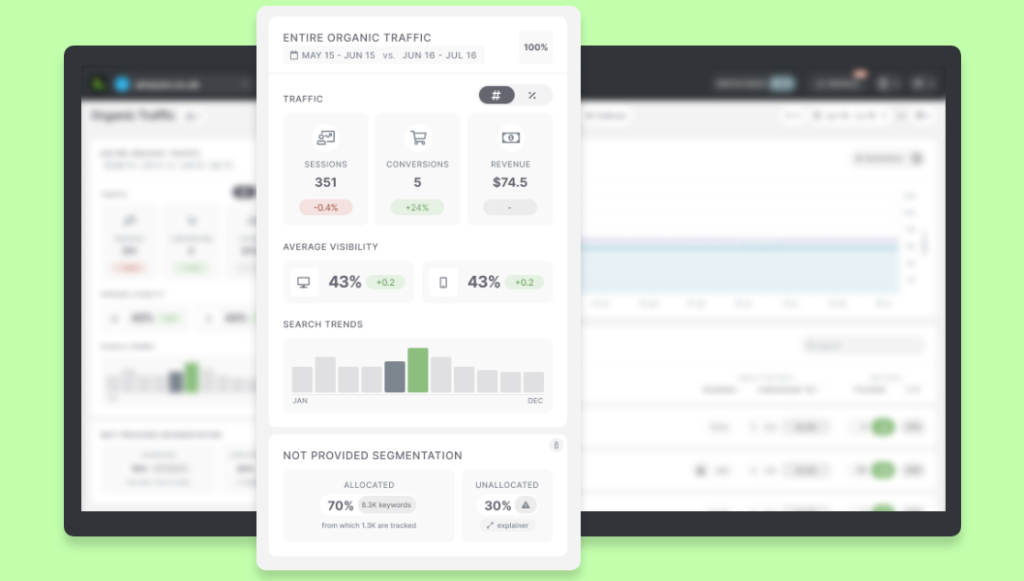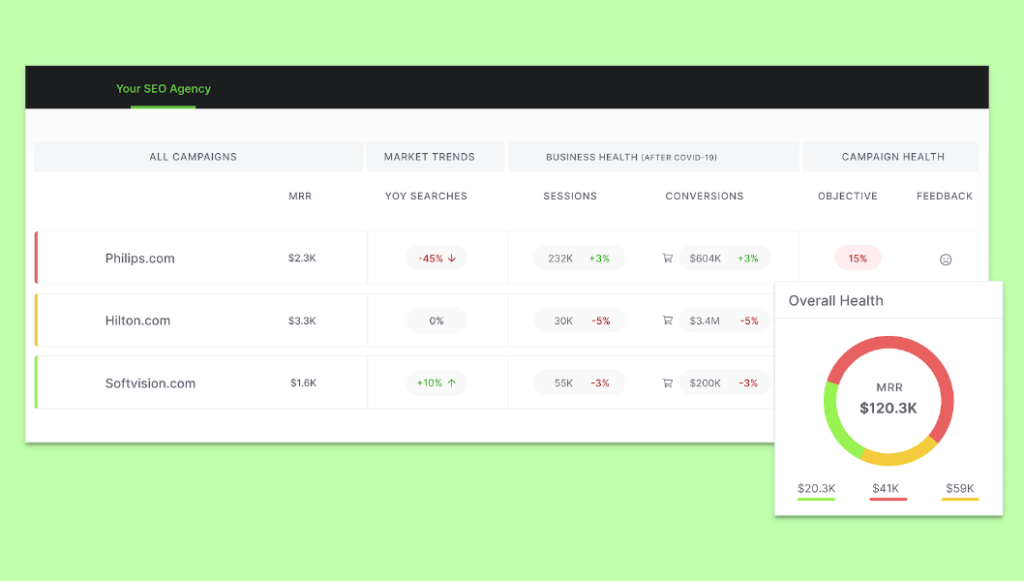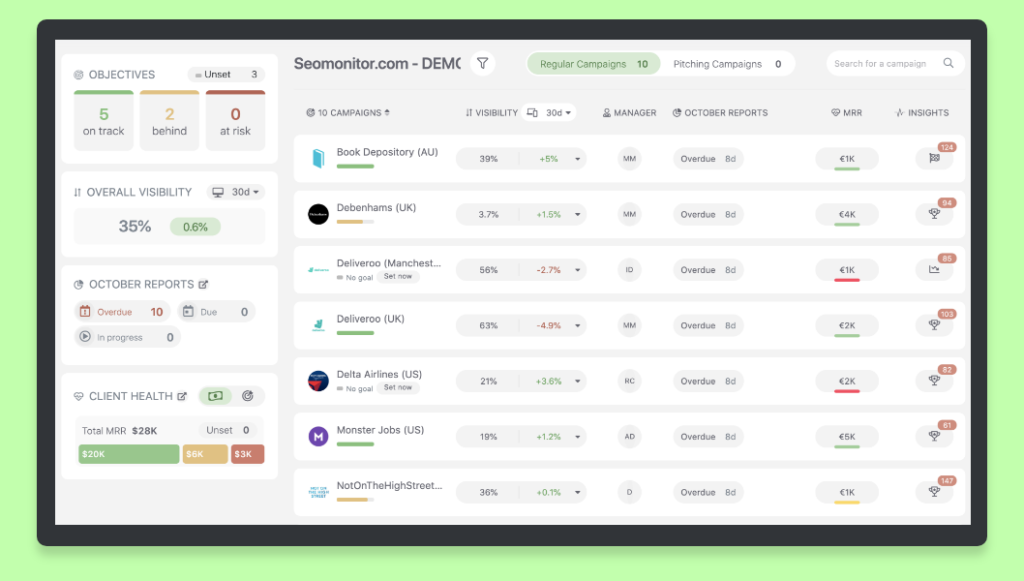30-second summary:
- The needs of an SEO agency are dynamic and change as the business grows
- From data accuracy to seamless functionality, the spectrum of SEO tools and their features is wide, but how do you decide?
- Five telltale signs that it might be time to start prospecting for new SEO software to complete your technology stack
The SEO industry is constantly changing and evolving. Your SEO agency’s needs also change as your business grows. The tools you use will shape how you direct your growth. So it’s important to stay up-to-date on what’s new in the space to decide whether adopting a new SEO tool would benefit your business.
Yet, it’s always a question of prioritizing what’s critical for your business requirements.
There are many factors at play here:
- Some SEO platforms solve problems that you maybe didn’t even know existed – to identify these, you need to stay abreast of new advancements in the industry
- Some solve a particular problem, which you’re already aware of – in these cases, it’s just about identifying which tool is the best fit for your agency’s needs
- Some offer a seamless experience that helps you optimize your SEO workflows
- Some offer competitive advantages in terms of features or pricing
In our interviews with top SEO agencies from around the globe, we’ve gathered various insights into the factors that most influence the decision to test, and even switch, to a new core SEO tool.
Here are some of the telltale signs that it might be time to start prospecting for new SEO software in your tool stack.
Content created in partnership with SEOmonitor.
1. Your current tool isn’t giving you the right data or functionalities
Accuracy and functionality are the biggest pain points SEO professionals have with their tools.
Does your current solution give you enough data? Does it provide the right data? If not, you may not be able to deliver on your SEO goals.
Have you ever come across either of these problems?
Unreliable or incomplete data
Some SEO platforms simply provide more data features than others, while others charge extra to view specific metrics, like:
- Google’s “(not provided)” data
- Brand/non-brand organic traffic segmentation
- Mobile vs. desktop traffic
Having this data is invaluable for SEO professionals. But having to pay for it granularly can be a hugely limiting factor, particularly for smaller agencies.
For example, mapping the traffic data from Google Analytics and matching it with the keyword data from Google Search Console to get what’s “(not provided)” means you can show clients the direct impact which SEO has on other business goals – like how increasing ranking for a keyword affects conversions.

SEO platforms that provide this type of data as standard can give you an advantage when it comes to acquiring and retaining clients by highlighting the connection between SEO and business results.
Or it can be an issue of unreliable metrics – misleading or opaque calculations, issues that pertain to technical changes and not your SEO performance, and so on.
Think about the visibility metric. If it’s calculated as an average of positions for a set of keywords, then changes based on adding or deleting keywords on that list will be misleading, leaving you to figure out why the score fluctuates.
Paul Wood, Director of Indulge Media, points out that innovation in how an SEO tool calculates a key metric is a deciding factor. Even more so if it’s something the agency used to do with spreadsheets and many hours spent before finding out about such an efficient metric.
“The more interesting scenario is when you suddenly become aware of a tool that’s out there that does something your team didn’t even consider,” Wood said. “When you see it in a tool, that’s a moment when you change the way you’re thinking about things, about how you structure your work. And then you start to work differently.”

This is how the right SEO tools should work – solving agency pain points, even the ones you might not have thought were possible to resolve.
Functionality issues
Speed is a huge factor in the SEO industry.
Search professionals need access to accurate, up-to-date data in the moment to implement campaigns and track performance.
Because when your software malfunctions, you need to get the problem solved fast.
This is why it’s essential to consider the quality of support provided when selecting an SEO tool.
Ideally, you should get access to a dedicated account manager who you can approach for quick resolution of issues on an as-needed basis, as well as regular support calls to review your agency’s needs.
When Paul Friend, Head of SEO, and Ben Foster, Managing Director, from SEO Works decided it’s time to choose a different core SEO tool, they scored ongoing and ad-hoc support as one of the “hundreds of different relevant aspects when selecting the right tool.”
As part of their decisional matrix, this was one point that needed to match key functionalities like keyword features including universal rankings, overall market visibility scores, content insights, forecasting and reporting capabilities, link building capabilities, competition insights, and many more.
After all, when you’re evaluating or considering upgrading your existing tech stack, you need to see how well a solution performs based on your agency’s specific needs.
2. You want to be seen as a leader in innovation
Digital is always moving, and SEO professionals have to be up-to-date with new developments to remain competitive. Agencies need to be at the forefront of innovation, so they constantly lookout for new technologies that will set them apart.
Paul Wood says that they “make an effort at least a few times a year to have a proper review of what’s out there in terms of tools.” They focus primarily on accessibility and UX when assessing new tools on the market, like:
- How easily they allow you to export data
- How they facilitate collaboration between internal teams and clients
- How many functionalities can be integrated into a single platform
The team at SEO Works also highlights the importance of always being on the lookout, with members keeping each other informed. They have an extensive training program in place, too – so everyone is onboarded not only with the tools but the specific methodologies the agency uses for top-notch SEO strategies.
Going even further, agencies like SEO Works develop proprietary tools, showing how their innovative approach can be a competitive advantage for clients in their portfolio.
3. You’re growing or scaling your SEO agency
Digital adoption has accelerated globally by at least three to four years in just a few months, according to a recent McKinsey Global Survey of C-level business leaders.
This drive toward a digital-first approach is only expected to continue, which means that scaling needs for SEO agencies are likely to be high right now, as well as for the foreseeable future.
Meeting this growing demand for SEO services requires agencies to scale operations efficiently while also staying competitive themselves. If you’re growing your agency, it’s a good time to test your tools and see if they have the right set of functionalities to promote and support this growth.
Fast-growing agencies need more capabilities, like:
- Access to more users: As you add new clients and employees, you want tools that allow you to have unlimited users (ideally, at no extra cost) and facilitate collaboration across teams
- Unlimited API access: Your SEO tools need to work seamlessly with your other business tools as you grow your overall technology toolkit. For example, we’ve made it as simple as possible to export large quantities of data through the SEOmonitor API, letting you pull the campaign and keyword-level data into your preferred internal systems (like Klipfolio) and customize client reports
- More efficient workflows: Operational dashboards, integrated systems, and organizing capabilities for your client portfolio, all make a difference in helping you get the status quo at a glance

In the words of many SEO professionals we’ve talked with, the highest value an SEO platform can bring is to help you not waste time.
The right tools will help you do this, but ineffective ones can leave your team spending too much time on technical processes, which will seriously impede your ability to scale.
4. Your tool isn’t collaborative enough or customizable
SEO professionals need to have stable processes and methodologies across all teams. The best software is built with this in mind.
Collaboration and customization are the most important things that agencies prioritize when choosing SEO tools. And lots of features facilitate this, like:
- Multiple user access: Unlimited access for team members and clients, with customizable client view permissions.
- Collaborative features: Real-time annotations, comments, and sharing capabilities for both teams and clients.
- Tracking metrics: A centralized agency dashboard that lets teams monitor performance and tasks, as well as align on goals.
- Personalization features: From filtering campaigns by account managers, to an editing mode that optimizes your time for keyword management, to saving customized reporting templates across the agency, there are many capabilities you should consider.

A robust SEO solution, which combines multiple functionalities like these in a single platform, helps optimize internal workflows and gain a holistic view into agency operations.
5. Your tool isn’t cost-effective
Different sized agencies have different budgets.
Optimizing costs is crucial, particularly for scaling agencies. You have to hire more people and use more resources in your tools to handle a larger volume of clients, and you don’t want to scale your costs at the same rate.
Some questions to ask when evaluating the cost-efficiency of a particular tool are:
Does it offer flexible pricing and use of resources?
Most SEO software solutions have a fixed subscription cost, which includes a set number of domains and keywords. But if your use of the tool’s resources fluctuates from month to month, your pricing remains the same.
Other platforms give agencies the ability to upgrade or downgrade each month, so you only pay for what you use. Having no predefined plan supports agencies better evaluate their expenses based on campaign volume on a specific timeframe.
Are there any extra hidden costs?
Some tools have an attractive base price but come with hidden costs and extras that can quickly add up, especially when you’re onboarding lots of new clients and handling larger campaigns. These include:
- Per-user costs: Will you be able to add unlimited users (including clients) at no extra cost to allow for internal and external collaboration?
- Migration fees: Is there an hourly or fixed rate for migrating from your existing system to a new tool?
- Integration costs: Are there multiple integrations to important tools of the trade (Data Studio, Google Sheets, API access, and more) included in the price?
So if your current software isn’t making the most financial sense for your business, it could be time to test a new one.
When is the right time to start prospecting for a new SEO tool?
The answer is, you should never stop your critical analysis.
Innovation is an ongoing process, especially in this rapidly-changing industry. So your core SEO tool of choice needs to keep up the pace and constantly update its capabilities.
When you encounter these signs with your existing solutions, they may not be serving you as well as they should be, like:
- When you don’t get access to the right data or functionalities.
- When you want to be a leader in innovation, which means you need innovative methodologies.
- When you’re growing or scaling your agency, and you need more capabilities in place.
- Or when you want to be more cost-effective.
We understand that an SEO agency’s core tools are crucial in winning more clients and managing them more efficiently.
That’s why our team at SEOmonitor is committed to designing specific solutions that help you acquire, manage, and retain relevant customers.
Join us and our SEO agencies community in the journey to bring more transparency and measurability to the SEO industry.

Alice Teodorescu is Content Marketing Manager at SEOmonitor.







